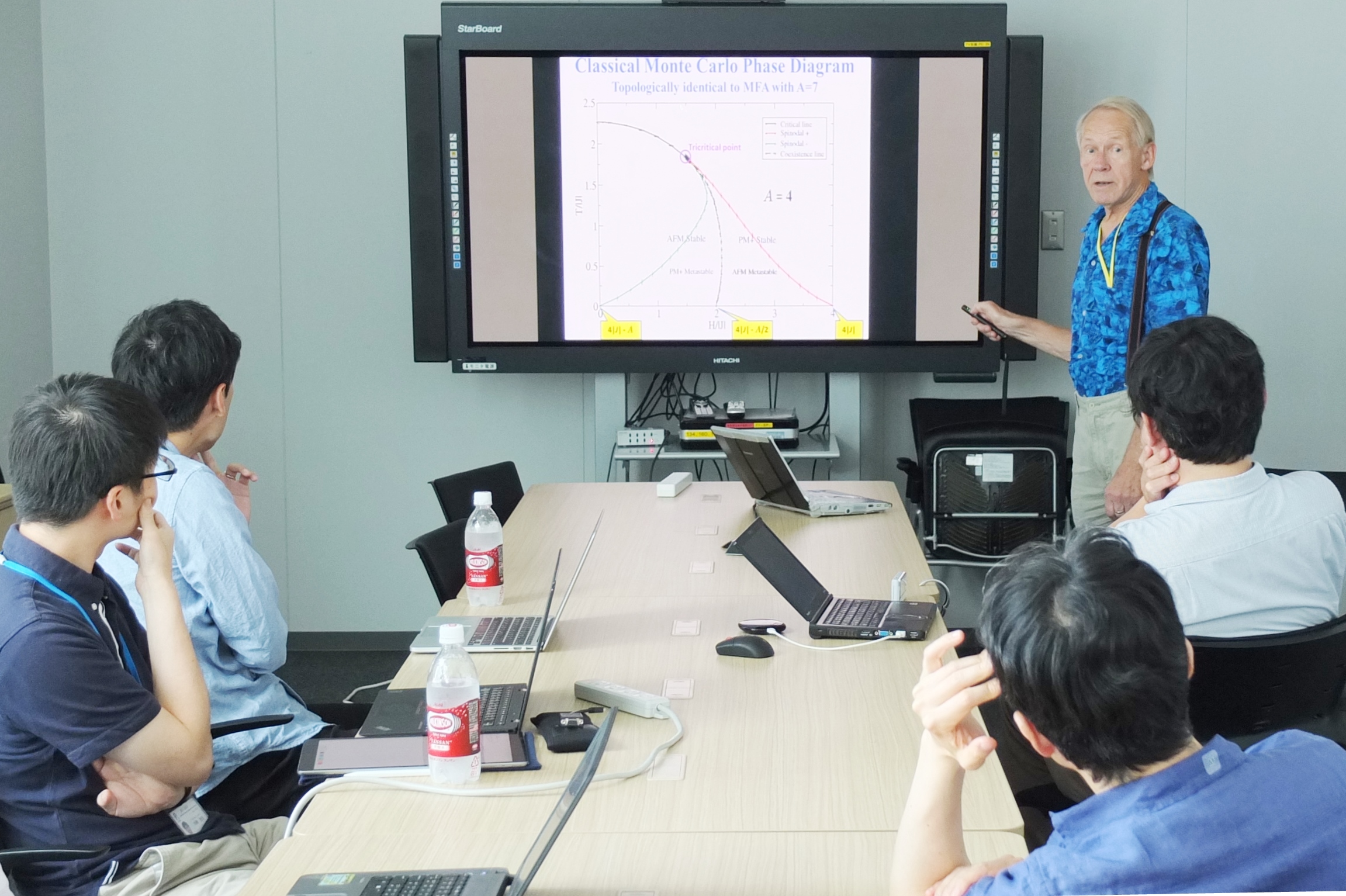

「離散事象シミュレーション」ミニセミナー開催報告(6月10日)
2016年6月10日、フロリダ州立大学 Per Arne Rikvold 教授の来日に伴い、理研AICSでは「離散事象シミュレーション」に関するミニセミナーを開催しました。
注目されるスピンクロスオーバー物質
温度や光や圧力等の影響で、物質の局所的な構造が変化する「スピンクロスオーバー物質」は、スイッチなどの役割を果たす機能材料として注目されているものの一つです。ただ、現時点ではその物性の変化などについて解明されていないことが多くあります。相転移の特性をよりよく理解するための方法の一つとして、「状態密度」を直接計算することが考えられますが、既存の手法では直接計算が難しいことから、新しい計算手法の開発が行われています。
計算手法の開発
今回のセミナーでは、既存の手法である「ワン・ランダウモンテカルロ法」を拡張し新たに開発中である計算手法の説明を行いました。その手法を使って得られた計算結果を、従来の手法(標準的なモンテカルロ法)による結果と比較し、その知見を共有しました。
詳しい内容
タイトル:短距離反強磁性と長距離強磁性相互作用を持つスピンクロスオーバー物質モデル:自由エネルギーランドスケープのワン・ランダウ計算
概要:スピンクロスオーバー物質は異なる長さスケールの競合する相互作用を持つシステムの興味深い例の一つです。これらの系では、幾何学的あるいは電子的な短距離相互作用を持ち、長距離相互作用としては典型的には弾性相互作用を持つような物質を挙げることができます。まず、そのような物質のシンプルなトイモデルとして、反強磁性最近接相互作用と平均場的な強磁性相互作用を持つ二次元正方格子のイジングモデルを紹介します。このモデルを標準的な重点サンプリングモンテカルロ法を使って計算したところ、複雑で興味深い相図が得られることが近年明らかになりました。
しかし、自由エネルギーランドスケープを二つの巨視的な秩序変数(磁化とスタガード磁化)の関数として書いた時にどのように見えるかという疑問にこのような計算手法では容易に答えることができません。我々はこのようなモデルの状態密度を直接計算するため、Wang-Landauモンテカルロ(WLMC)法を用いた新しい手法を開発しました。本セミナーでは、オリジナルのWLMC法について簡単に紹介した後、我々が特定の秩序変数における状態密度を計算するために行った拡張について説明します。計算された自由エネルギーの様子をいくつかのパラメータについて示し、標準的なモンテカルロ法で得られた相図と比較します。この比較によって、競合する短距離・長距離相互作用があるモデルにおける準安定状態の性質について新たな興味深い疑問が浮かび上がりました。共有し、今後の開発につなげていきたいと考えています。
英語原文:
Title: Model Spin-crossover Material with Short-range Antiferromagnetic and Long-range Ferromagnetic Interactions: Wang-Landau Calculation of Free-energy Landscapes
Abstract: Spin-crossover materials present an interesting example of systems with competing interactions on different length scales. In these systems, the short-range interactions may be geometric or electronic in nature, while the long-range interactions are typically elastic.
Here I present a “toy model” of such a system: a square-lattice Ising model with nearest-neighbor antiferromagnetic and mean-field like long-range ferromagnetic interactions. Using standard importance sampling Monte Carlo (MC) methods, we have recently obtained rather complex phase diagrams for this model in several parameter regimes. One question that cannot easily be answered by these methods, is that of the structure of the free-energy landscape in the space of the two macroscopic order parameters: magnetization and staggered magnetization. We have therefore developed a new method to directly obtain the density of states (DOS) of such a model, using the Wang-Landau MC (WLMC) method. I will give a brief introduction to the original WLMC method, and then describe the modifications we have made to obtain DOS constrained to specific values of the order parameters. I will show numerical free-energy landscapes for several parameter values and compare the results with phase diagrams previously obtained with importance sampling MC. The comparison raises some new questions about the nature of metastable phases in models with competing short-range and long-range interactions.


